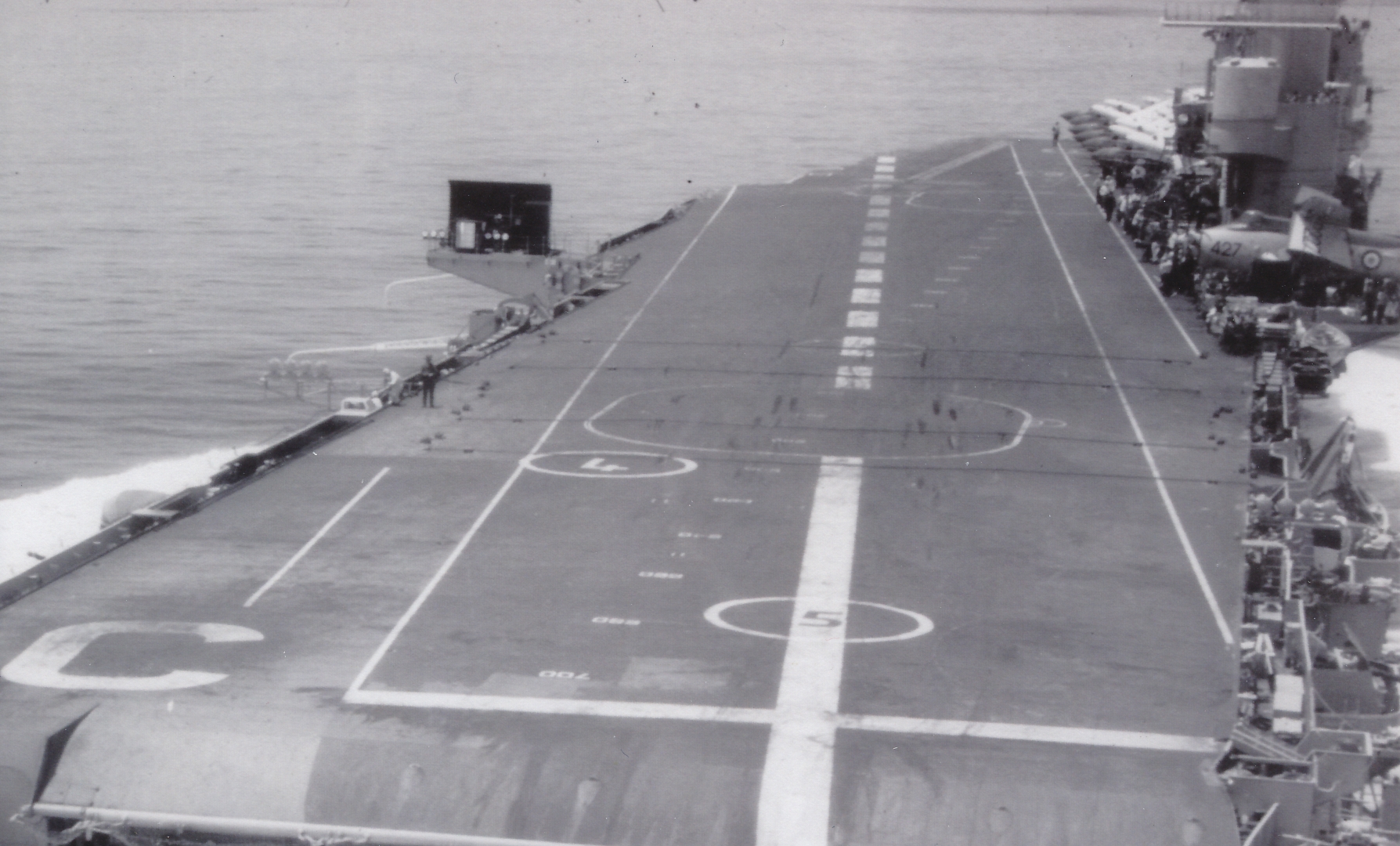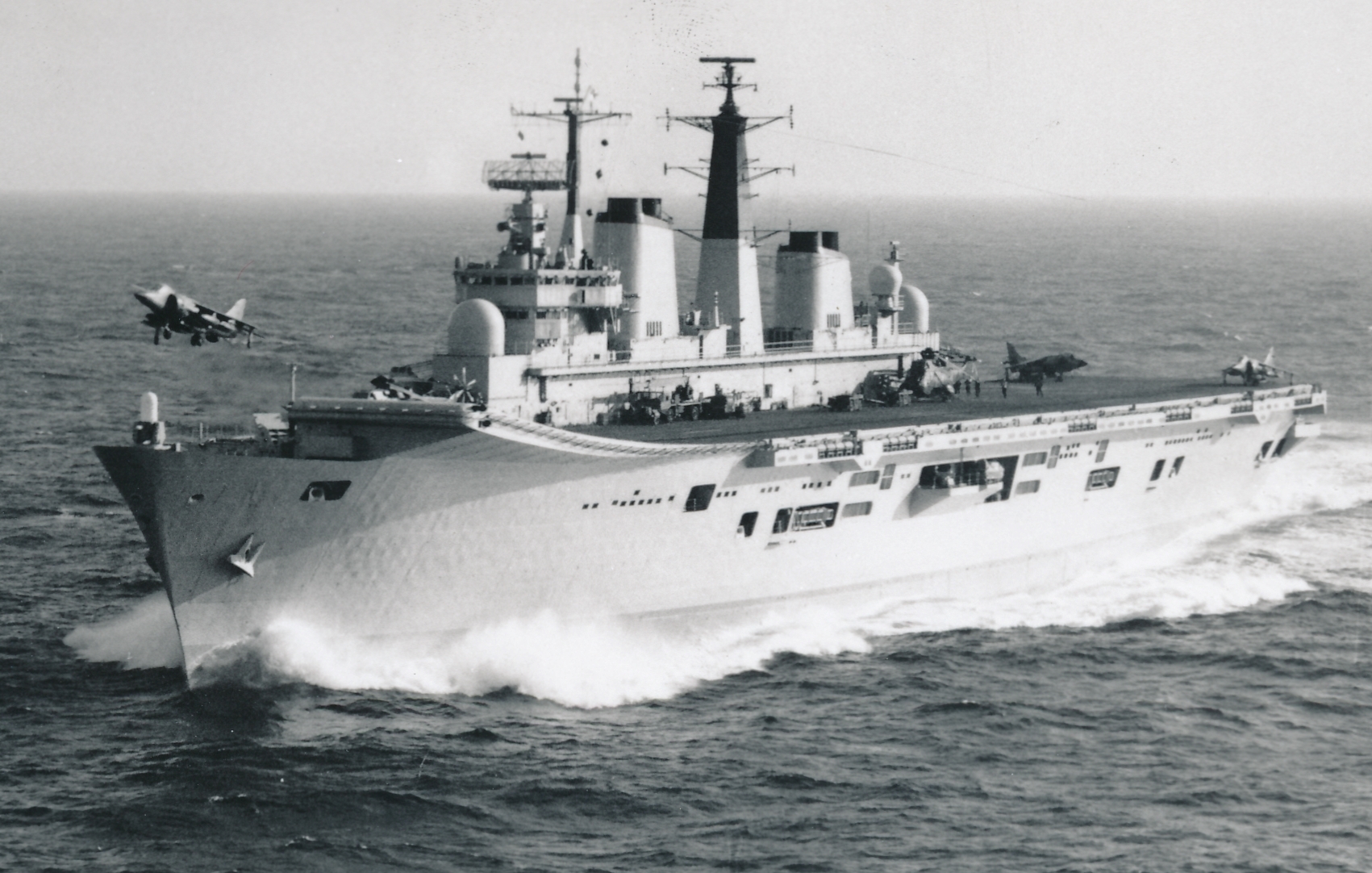David Hobbs: British aircraft carrier design that led the world – Part 2
We hope you enjoyed our recent guest post from David Hobbs. Here is the second part. Enjoy!
The Mirror Landing Aid
The third major problem in 1951 was the indication to pilots of an ideal flight path to land jet fighters on deck at increasingly high speeds. A Sea Vampire made a series of downwind approaches to Illustrious during trials which confirmed that ‘batsmen’, no matter how experienced, were unable to appreciate errors in height or line quickly enough to signal them in time for the pilot to make corrections. Once more the solution came from a serving naval officer, Commander H C N Goodhart RN who was Captain Campbell’s assistant at the MoS. He was a pilot with an engineering background and his solution was to place a large mirror facing aft by the port deck edge with a source light 150 feet aft of it, projecting a point of light onto the mirror. By tilting the mirror back slightly, an ideal pre-determined but adjustable glide slope indication was shown to pilots on final approach with the reflected ‘blob’ of light, soon to be known universally as the ‘meatball’ or simply ‘the ball’ in between green datum bars of projected light on either side of the mirror. If the ball appeared exactly between the datum bars, the pilot’s eye was exactly on the ideal glide slope for his hook to catch the target arrester wire. If it moved above the datum bars he was high and if it moved below them he was low. Reaction time lags were reduced to those of the pilot himself and potential misinterpretation of hand signals was eliminated. By adjusting the brilliance of the source lights, the pick-up range of the mirror could be increased or decreased. In practice two or more source lights were installed so that the failure of any one would not render the sight useless.

The equipment was known as the deck landing mirror sight, DLMS, and the Admiralty tasked the RAE with the production of prototypes for evaluation ashore and at sea as soon as possible. The first mirror was installed on HMS Illustrious in October 1952 and comprised a convex, polished steel sheet on a wooden backing frame with reflective metal datum bars. Whilst crude, it showed promise and a more effective sight was designed by Mr D Lean at the RAE. This comprised an aluminium-faced mirror with aft-facing green lights as datum bars and it had a gyro stabilisation system to cancel out the effect of ship pitch. It was installed on HMS Indomitable in June 1953 and sea trials were carried out with landings made by a variety of operational naval aircraft. These were witnessed by RCN, USN and USMC observers and some of the landings were flown by American as well as British pilots. The exact point where the hook would hit the deck could be selected with considerable accuracy by adjusting the tilt of the mirror and the trial proved extremely successful. The sight solved the problem of giving pilots of aircraft with high approach speeds adequate glide slope information and also meant that the number of arrester wires could be reduced from an average of 12 in 1950 to just 4 with complete safety; thus reducing both the amount of installed flight deck machinery and the number of technical ratings needed to maintain it. The reduction in the number of wires meant that those fitted could be sited further forward, nearer the centre of pitch and further from the after round-down giving greater clearance for the tail hook in rough weather. The new angled deck and mirror sight together not only made deck landing safer, they made it easier. Within the space of two years at a time of financial and manpower stringency, the RN had carried forward a revolution in carrier operating techniques that was adopted by every navy that operated aircraft carriers.
The ski-jump
Like the steam catapult, angled deck and mirror landing aid before it, the ski-jump was conceived by a serving naval officer, in this case Lieutenant Commander D R Taylor RN. Before his ingenious idea, the light carrier design that evolved into HMS Invincible had envisaged launching Sea Harrier fighters from a rolling take-off taking most of the ship’s flight deck. By the time it reached the forward edge of the flight deck a Sea Harrier would, typically, have accelerated to about 90 knots and with a wind over the deck, WOD, of 20 knots this gave it an end speed of 110 knots relative to the free stream air passing over the ship. This was still below the wing’s stalling speed and so when he reached the bow the pilot would select the engine nozzles down to about 50 degrees relative to the fuselage and raise the nose slightly to give optimal wing incidence. Most of the aircraft weight would, thus, be borne by engine thrust but a proportion of that thrust was still directed aft, continuing to accelerate the aircraft. Once the wing’s stalling speed was exceeded the pilot rotated the nozzles fully aft and the aircraft was flown like a normal fighter. This technique was practised in Hermes from 1977 onwards using Harrier development aircraft and prototype Sea Harriers flown by test pilots. There was insufficient engine thrust to allow the aircraft to take off vertically loaded with with full fuel and weapons but a rolling, short take-off allowed the aircraft to launch from a flat deck 30% heavier than the maximum weight at which vertical take-off would have been possible.
The P 1127/Kestrel/Harrier/Sea Harrier series of aircraft were particularly well suited to this form of short take-off from a carrier deck since, being designed to hover before landing, they were fitted with a system of flying controls that worked when the wing was not giving lift and there were minimal forces acting on the tailplane and rudder. When the aircraft were in wing-borne flight they used conventional elevators, ailerons and rudder. When the engine exhaust nozzles were rotated below 10 degrees these surfaces continued to move but, additionally a series of puffer jets, fed by pipes which took high-pressure air bled from the engine were activated. These gave the pilot control authority using his conventional controls. A flat deck launch, however, left the aircraft low and slow close to the surface of the sea for up to 15 seconds after launch and at night or in bad weather this was clearly not ideal. Any sort of malfunction would leave the pilot very little time to eject. Another drawback was that Sea Harriers would not always be able to achieve their full load-carrying potential from the small deck run available in Invincible and her sister-ships.

Taylor’s proposal was a curved ramp or ‘ski-jump’ at the forward end of the flight deck which allowed the aircraft to leave the deck after nozzle rotation at the apex of a curve at a speed which could be significantly less than that needed for a flat-deck take-off. This effect could be translated into a much shorter deck run or a higher launch weight. A 20 degree ski-jump offered a launch speed reduction of 30 knots at a given aircraft weight compared with a flat deck. At the highest aircraft weights associated with strike missions this represented a 30% reduction in launch end-speed which, because the take-off deck run depends on speed squared, reduces the required deck run by about 50%. At the lower short take-off weights associated with fighter missions the decreased end-speed requirement represented a 40% reduction in velocity and required a deck run of only about one third of that needed for a flat deck launch. Alternatively, from a longer deck run end-speed remained comparable with that achieved with a flat deck launch; only about 4 knots being lost ‘climbing the hill’. The aircraft was, thus, effectively launched with 30 knots excess end-speed and could carry 30 knots x 66lb per knot or roughly 2,000lb more payload than it could from a flat deck. Of interest, the US Marine Corps considered the concept for its AV-8 Harriers but elected to retain flat decks on its amphibious carriers to allow more space for helicopter operations. They do, however, have the advantage of a deck run nearly twice as long as that in Invincible but still have to accept the low, slow climb away from the deck.
A ‘ski-jump’ was erected at RAE Bedford made from Fairey girder bridge components and trials were carried with development Harriers and Sea Harriers. Theoretically launch performance increased with ‘ski-jump’ angle but in practical terms, there was an optimum end-speed corresponding with maximum launch weight. For a desired maximum launch weight there was a minimum angle, the size of which was derived from the radius which would avoid undercarriage stress becoming a limiting factor at that weight. This effectively sized the ‘ski-jump’ since excess load factor was proportional to end-speed squared divided by the radius of the curve. In practice, practical curve radii for the Sea Harrier was found to lie in the range 600 to 800 feet. The application of Euclid’s law then determined how long and how high the actual ‘ski-jump’ structure would be for a given exit angle. The size of the structure was found to grow markedly above 12 degrees and this was a dis-incentive to considering bigger angles. The advantages of the ‘ski-jump’ were immediately apparent and work was put in hand by the RN Ship Department to evaluate its installation on Invincible. The result was positive but cautious. A small 7 degree ‘ski-jump’ was fitted to the first 2 Invincible class ships but HMS Hermes was fitted a larger 12 degree structure which was installed during the ship’s 1980 conversion in Portsmouth. This was to prove far more effective and was copied on the third ship of the Invincible class, HMS Ark Royal. The first two ships were subsequently modified with 12 degree ‘ski-jumps’ during refits. The Hermes structure was found to be ideal and the ‘ski-jump’ fitted in the Queen Elizabeth class 40 years later for the operation of F-35B Lightning II fighters is similar.

The British Carrier Strike Fleet is available to order here.

